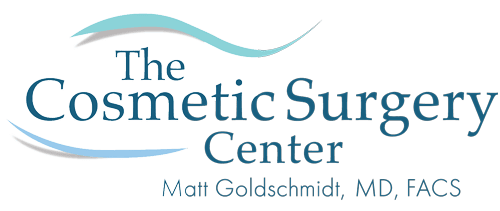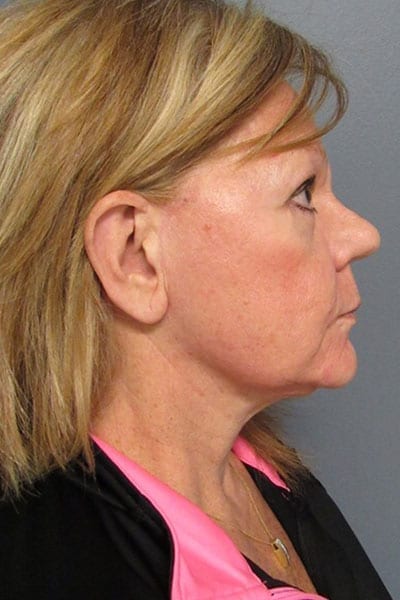Are You a Candidate for Facelift Surgery?
Facelift surgery addresses noticeable signs of aging on the face and neck. Candidates for facelift surgery are non-smoking, healthy adults who are displeased by their visible aging. Candidates must have realistic expectations of what the surgery can provide.
Facelift surgery can benefit individuals who:
- Experience moderate to severe fine lines and wrinkles
- Have displaced facial fat
- Develop deep creases and folds between the nose and mouth
- Have moderate to severe jowls
- Experience vertical banding on the neck
- Develop a double chin
To see if you are a candidate for facelift surgery, please call Dr. Goldschmidt at The Cosmetic Surgery Center at (216) 350-3175 to set up a consultation.
How Is Facelift Surgery Performed?
Facelift surgery is completed under twilight sedation or general anesthesia. This procedure takes a few hours to complete, depending on the extent of correction needed.
Separate incisions are made on the sides of the head that begin in the hairline in front of the ear and continue down and around the ear. Underlying facial muscles and fat are tightened, repositioned, and sutured to create a lifted effect. Sagging skin is trimmed along the incision line, and the incisions are closed using removable sutures.
An incision is made beneath the chin to address laxity on the neck. Neck lift surgery is performed to lessen the appearance of vertical banding and loose folds along the neck and jawline.
Should I Combine Liposuction With My Facelift?
Occasionally, facelift and neck lift patients have excess submental fat, commonly referred to as a double chin. This excess fat can be lessened with liposuction of the neck and face.
What Can I Expect From My Facelift Recovery?
Facelift surgery is an outpatient procedure, and you can return shortly after your anesthesia wears off. Your incisions will be wrapped with dressings that will protect the incisions and speed the healing process.
You will be sore, bruised, and swollen for the first few days of your facelift recovery. Your sutures will be removed after one week. During this time, you should rest and sleep with your head elevated to promote blood circulation. Prescribed or over-the-counter pain medication will alleviate any post-operative discomfort.
Most facelift patients return to work within two to three weeks.
When Will I See My Facelift Results?
Your facelift results will begin to show immediately following your surgery. However, as there will be significant bruising and swelling, it may take several weeks or months for the full extent of your results to develop. Most bruising will dissolve within the first three weeks, but swelling may persist for six weeks or more.
Once the bruising and swelling dissolves, patients can expect to look significantly younger with smoother skin and more defined facial contours. Resulting scars are well-hidden in the hairline or under the chin. To help minimize the appearance of the scars, patients should keep the healing incisions out of the sun and apply silicone strips or gel.
The results of your facelift are not permanent. Additional skin laxity will occur with time, but you will always look younger and more refreshed than if you did not undergo facelift surgery.
Frequently Asked Questions About Facelift Surgery?
Will I need to combine a neck lift with my facelift?
While it is not absolutely required, most patients find that it is best to address the neck along with the face. The skin on the neck develops laxity at the same rate—if not faster—than the face. Therefore, addressing the face without the neck puts you at risk of looking out of balance.
Will facelift surgery address my aging eyes?
A facelift addresses visible aging on the middle and lower regions of the face. It does not address aging on the eyelids or forehead. For patients with significant laxity on the upper third of the face, blepharoplasty and/or brow lift surgery may be recommended to address these signs or to maintain a balance between the facial features.
Alternatively, BOTOX® Cosmetic can be used to smooth expression-related fine lines and wrinkles around the eyes. These lines include crow’s feet, frown lines, and forehead lines.
Are there non-surgical alternatives to a facelift?
While facelift surgery is the best way to address moderate to severe signs of aging, some qualifying patients may qualify for a liquid facelift. This non-surgical treatment is ideal for men and women with mild to moderate signs of aging. A liquid facelift combines a series of injectable treatments. It is appropriate for individuals looking to improve the appearance of facial creases, fine lines and wrinkles, hollow cheeks, and thinning lips.
What are the risks associated with facelift surgery?
As with any surgical procedure, facelift surgery comes with the potential for risk even though that potential is very small. These risks include:
- Negative reactions to the anesthesia
- Bleeding
- Infection
- Blood clots
- Prolonged healing
Aesthetic risks include:
- Unfavorable scarring
- Facial asymmetry
Are You Interested in Facelift Surgery in Independence, Ohio?
If you are interested in learning about facelift surgery or you would like to see what your facelift cost would be, contact Dr. Goldschmidt at the Cosmetic Surgery Center by calling (216) 350-3175 or by filling out our online contact form. Dr. Goldschmidt sees patients from Independence, Cleveland, and the greater Cleveland area.
For more information about Facelift in Cleveland, OH or to schedule your Facelift in Cleveland, OH consultation with Dr. Matt Goldschmidt, please call (216) 264-8100.


